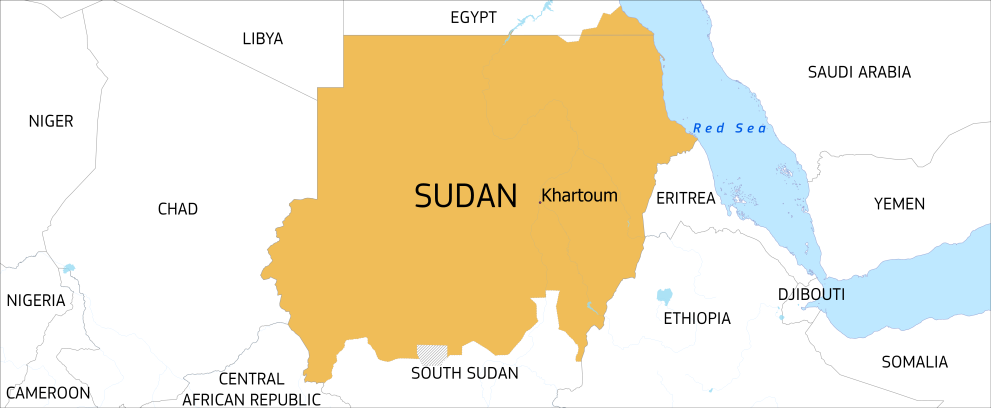Introduction
Violent armed clashes broke out in Khartoum on 15 April 2023 between the Sudanese Armed Forces (SAF) and the Rapid Support Forces (RSF). Two years into the conflict, its humanitarian toll is disastrous. Warring parties are using heavy weapons in densely populated areas, with devastating consequences for civilians, and applying practices that may amount to war crimes. Food insecurity is catastrophic: famine has expanded to multiple areas in the country. Sudan is now facing the largest displacement crisis in the world, with over 11.5 million people internally displaced and 3.5 million who fled across borders, mainly to neighbouring countries.
What are the needs?
More than 30 million people (64% of the Sudanese population), including 16 million children, urgently need humanitarian assistance in the country.
The protection crisis in Sudan has reached an unprecedented scale, with human rights violations and abuse, including retaliatory attacks against civilians based on their alleged affiliation or ethnicity, staggering levels of sexual and gender-based violence (SGBV), targeted attacks on healthcare facilities and the energy infrastructure, and the recruitment and use of children by warring parties. UNICEF estimates that about 16.5 million children in Sudan, approximately 80 per cent of Sudan’s children, are out of school.
The food insecurity and nutrition situation is catastrophic. The latest Integrated Food Security Phase Classification (IPC) projection, released in December 2024, estimated that 24.6 million people would experience acute food insecurity, including famine, in Sudan by May 2025. These already critical levels of acute food insecurity and malnutrition are now expected to deteriorate and expand even before May due to the ongoing conflict, displacement, the early start of the peak season, limited access and cuts in funding. This includes 10 areas of the country facing famine and 17 other areas at risk of famine by May 2025.
Throughout the country, 75% of health facilities in conflict-affected areas are considered out of service.
Shortages of food, clean water, medicines, cash, and fuel, along with limited communications and electricity, are being reported throughout the country.

The conflict has produced the world's largest displacement crisis, with over 15 million displaced people reported so far (April 2025). Out of these:
- over 11.5 million people are internally displaced,
- over 3.5 million people have fled outside Sudan.
Out of the 30 million people in need in Sudan, 9 million are in Darfur. This represents 30% of humanitarian needs in the country.
Despite these critical needs, humanitarian actors operating in the country are facing severe access constraints and systematic obstructions which hamper their presence and ability to scale up their response.

How are we helping?
In 2025, the EU has allocated €160 million for lifesaving assistance to the most vulnerable in Sudan, out of which €70 million are subject to the approval of the budgetary authority.
This brings the overall EU contribution to the regional response to the Sudan crisis, both in Sudan and in the neighbouring countries affected by the crisis, to a total of €269 million in 2025.
In 2024, the EU mobilised €260 million for the humanitarian response in Sudan and in neighbouring countries. This included €147 million for the response inside Sudan.
Through its ReliefEU capacities, the EU has completed 13 Humanitarian Air Bridge (HAB) flights to transport over 640 tonnes of assistance through Chad and Port Sudan in 2023, and 2 flights in 2024, transporting 187 tonnes of humanitarian assistance to support the cross-border response from Chad to Sudan. In addition to this, 127 tonnes of medical supplies were transported from Dubai to Port Sudan via multi-modal transport.
EU humanitarian aid provides communities with health and nutritional care, cash, food assistance, water and sanitation, shelter, protection, and education to the most vulnerable households – the internally displaced, refugee families, and host communities.
The EU also contributes to the nutritional treatment and care of children under 5 and pregnant or breastfeeding women across Sudan.
Advocacy is also an essential component of the EU’s response to the humanitarian crisis in Sudan, as illustrated by the high-level events co-organised by the EU in 2024 and 2025 – including the Third Humanitarian Senior Officials Meeting on 13 March 2025 in Brussels and the London Sudan Conference on 15 April 2025.
The EU continues to promote compliance with international humanitarian law for unhindered and safe access for humanitarian aid and the protection of civilians.
The safety and security of aid workers, premises, and assets in Sudan must be guaranteed so that they can provide emergency assistance to those affected, including via the following:
- waiving travel restrictions for humanitarian personnel and granting travel permits to move beyond Port Sudan,
- providing aid workers with immediate safe passage and guarantees for access and movement by road and air,
- fast-tracking visa applications to allow for the scaling up of humanitarian operations,
- easing customs restrictions to expedite imports of operational supplies,
- ensuring the safe movement of humanitarian staff and supplies without imposing armed escorts, which are putting their security, independence, and neutrality at risk.
Last updated: 10/04/2025
Facts & figures
30 million people in need of humanitarian assistance in the country. This includes 16 million children – the future of Sudan.
24.6 million people projected to be in acute food insecurity, including famine, by May 2025.
More than 8.85 million newly internally displaced since April 2023 and 3.5 million in cross-border displacement, as of April 2025. It is estimated that in total there are at least 11.5 million internally displaced persons in Sudan, the highest number globally.
Sudan hosts approximately 15 per cent of all IDPs worldwide: 1 in 7 IDPs is Sudanese.
For the last fifteen years, Sudan has consistently been among the five countries with the highest number of IDPs by conflict and violence in Africa, and among the top ten globally.
EU humanitarian funding in Sudan:
€160 million in 2025 (including an additional €70 million subject to the approval of the budgetary authority)
€147 million in 2024
€960 million since 2013

